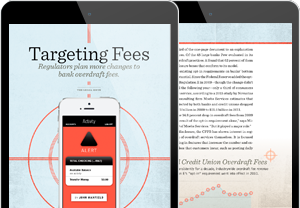
Targeting Fees
Federal regulators have made it clear that they will soon implement rules that govern more strictly how banks assess overdraft fees. The expected move will be the first since regulators began requiring banks to get written authorization from customers to opt in to overdraft programs, starting in 2010.
The Consumer Financial Protection Agency (CFPB) announced in November that it is preparing to launch a rulemaking to increase consumer protections concerning overdrafts and checking accounts. The process, which is expected to kick off later this year, goes hat in hand with CFPB Director Richard Cordray’s efforts to improve consumer access to financial products.
“Over the years, overdraft programs have become a significant source of industry revenues, and a significant reason why many consumers incur negative balances,” said Cordray at a recent field hearing on checking account access. “Too many problems with overdrafts can cause people to give up on the banking system or force them out of it altogether.”
To this end, the CFPB director sent a letter at the beginning of February to 25 of the nation’s largest retail banks, suggesting that they offer lower-risk checking or prepaid accounts that eliminate the possibility that a customer can incur a negative balance. Cordray pointed in accompanying remarks to guidelines issued by the Federal Deposit Insurance Corp. (FDIC) for cost effective accounts that are safe and affordable for consumers, known as the FDIC Model Safe Accounts Template.
Cordray also cited the National Account Standards established by the Bank On movement, a consortium of partnerships between financial institutions and local communities. The standards build on the FDIC’s work by laying out more than two dozen account features designed to attract unbanked consumers. These include making overdraft fees all but impossible by offering checkless checking accounts that exclude overdraft services on debit card transactions.
Multiple banks had already heeded this call. In June 2014, for instance, Cleveland, Ohio-based KeyCorp’s KeyBank launched its Hassle-Free Account, which allows customers to make deposits, track money, obtain cash and make payments without incurring overdrafts. A spokesperson for the bank said in an emailed statement that the lower-risk account “expands our ability to serve both the unbanked and those locked out of the banking system today.”
Capital One Financial Corp. offers a similar product, known as 360 Checking, which permits overdrafts but instead of charging a punitive fee it assesses interest only on the amount of the overdraft. It also offers free transfers from a linked savings account to cover any overage. The McLean, Virginia-based bank didn’t respond to a request for comment.
Beyond its efforts to encourage banks to offer lower-risk checking accounts, a CFPB spokesman made it clear that it will soon supplement rules that govern even standard checking accounts. The Bureau’s latest rulemaking agenda highlights multiple “consumer protection concerns” related to overdrafts that it is seems intent on remedying. These include the structure of overdraft and insufficient funds fees, the order in which banks post checking account transactions, and the way that consumers opt-in to overdraft coverage for debit card transactions.
The CFPB’s concern about opt-in requirements manifested itself in an enforcement action that the Bureau brought last year against Regions Financial Corp., a $126 billion asset bank based in Birmingham, Alabama. The CFPB fined Regions $7.5 million and ordered it to refund roughly $50 million in fees that it said had been assessed against customers who had not opted in for overdraft services. It was the first time that the CFPB has used its authority under Regulation E, which was revised in 2009 after Congress passed a law to require that customers opt in to overdraft protection.
The Bureau followed this up in October by notifying TCF Financial Corp. that it might take similar action against the $21 billion asset Wayzata, Minnesota-based banking company. TCF responded to the CFPB’s allegations in late November and believes that its overdraft opt-in practices comply with all applicable laws and regulations, said Mark Goldman, TCF’s director of corporate communications, in an emailed statement.
The biggest problem with opt-ins, according to studies by the Pew Charitable Trusts, is that bank customers often don’t understand how the process works. In a 2014 survey, Pew found that 52 percent of respondents who had overdrawn their checking accounts over the previous year did not recall opting into the service. Beyond this, “many consumers are confused about how the opt-in process works,” says Susan Weinstock, Pew’s director of consumer banking. “They think that opting in will allow them to avoid overdraft fees, when the opposite is in fact the case.”
Pew has published a model disclosure box that banks can use to remedy this. It lays out general account information and dedicates roughly a third of the one-page document to an explanation of overdraft services. Of the 45 large banks Pew evaluated in its 2015 report on overdraft practices, it found that 62 percent of them have adopted disclosure boxes that conform to its model.
The impact of existing opt-in requirements on banks’ bottom lines has been substantial. Since the Federal Reserve added the opt-in requirement to Regulation E in 2009-though the change didn’t go into effect until the following year-only a third of consumers have agreed to the service, according to a 2015 study by Novantas Research. Bank consulting firm Moebs Services estimates that overdraft fees collected by both banks and credit unions dropped from a peak of $37.1 billion in 2009 to $31.6 billion in 2011.
“To be clear, the 14.8 percent drop in overdraft fees from 2009 to 2011 wasn’t the result of the opt-in requirement alone,” says Michael Moebs, CEO of Moebs Services. “But it played a major role.”
In addition to disclosure, the CFPB has shown interest in regulating the design of overdraft services themselves. It is focused especially on reining in features that increase the number and extent of overdraft fees that customers incur, such as posting daily checking account transactions from the largest to the smallest dollar amounts, as opposed to chronologically.
Many large depositories have already eliminated this practice, says David Pommerehn of the Consumer Bankers Association.
They were incentivized to do so after paying hundreds of millions of dollars in legal fines and settlements stemming from the practice over the past decade. A federal district court judge in 2010, for example, issued a scathing indictment of the practice at Wells Fargo & Co., calling it a “draconian” bookkeeping device that “dramatically multiplied” the number of fees the bank could extract from a single mistake made by a customer. Wells Fargo declined to provide a comment for this article.
Weinstock believes that other features of bank overdraft policies are similarly likely to attract attention from the CFPB. These include reducing or eliminating extended overdraft fees (the fees banks sometimes charge when a customer hasn’t repaid the overdraft within a specified period of time), capping the number of overdraft fees assessed on a customer in any given year, and ensuring that the size of the fees are reasonable and proportional to the costs of the service. The Pew Research Trusts enunciates these and other best practices related to overdraft policies in its 2015 update to its Checks and Balances report.
There’s no question that overdraft services are important. “In many instances, overdraft services are the last refuge for consumers in need of immediate credit,” explained the CBA’s Pommerehn. However, it seems increasingly apparent that banks will soon no longer be permitted to design these services without taking into consideration a more holistic view of consumers’ best interests.

Join OUr Community
Bank Director’s annual Bank Services Membership Program combines Bank Director’s extensive online library of director training materials, conferences, our quarterly publication, and access to FinXTech Connect.
Become a Member
Our commitment to those leaders who believe a strong board makes a strong bank never wavers.




